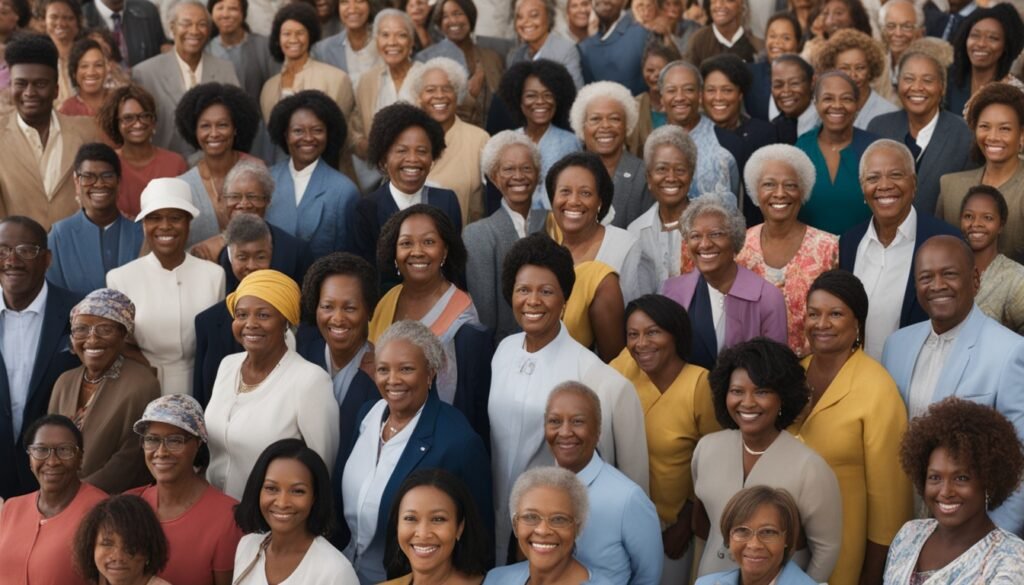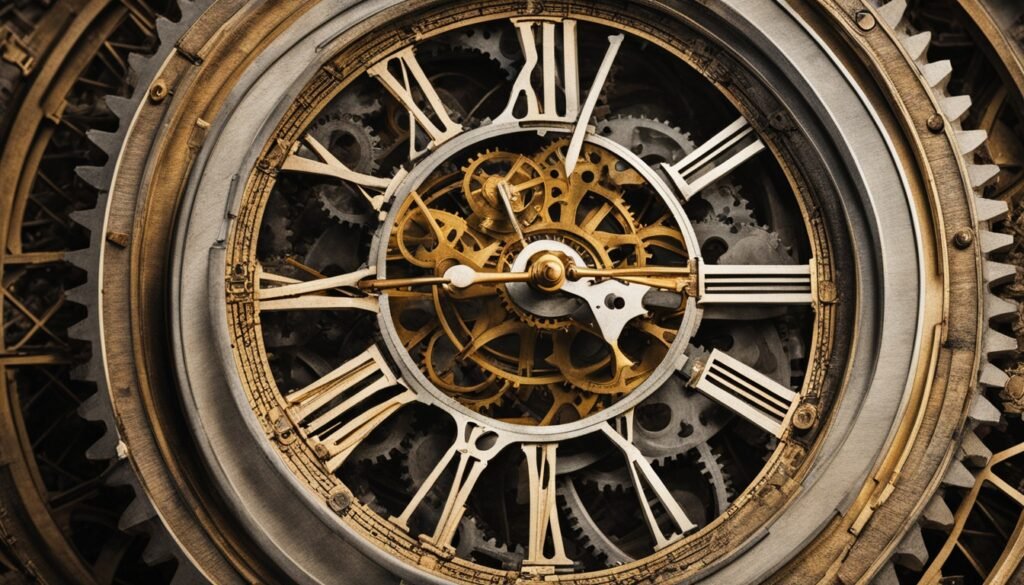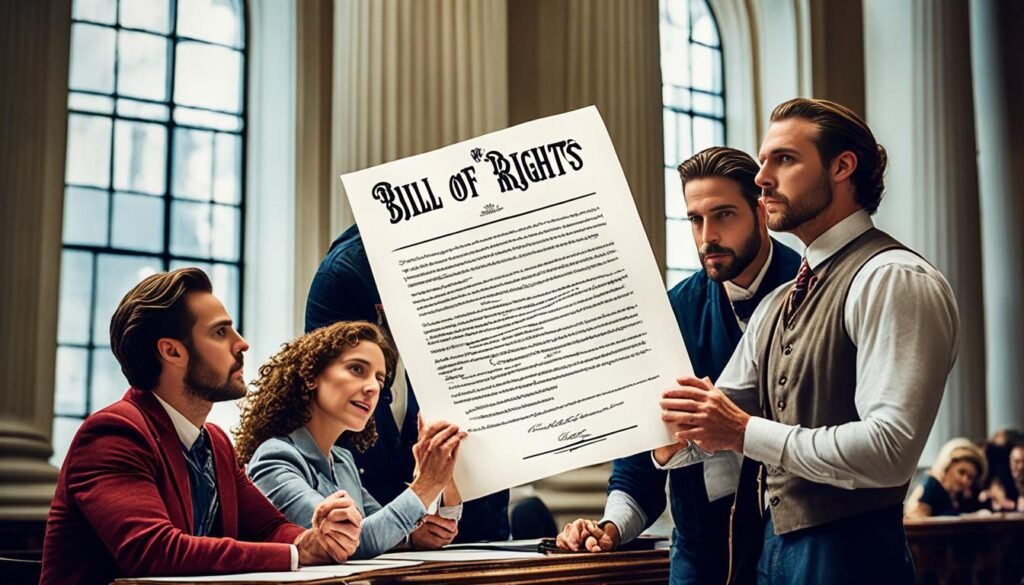The Constitution sets out how the United States government works. It defends the key rights of American citizens. This makes it the cornerstone of democracy. The Constitution creates a government where powers are divided and shared. It has checks and balances in place.
Also Read: The Process Of Legislation: From Proposal To Law
It also explains how to change the Constitution. The Founding Fathers wrote it at the Constitutional Convention in 1787. The states approved it in 1788. Since then, it’s been changed 27 times. The first ten changes are known as the Bill of Rights and were approved in 1791. Today, the Constitution is still the most important law. It guides important ideas like federalism and separation of powers. It also protects civil liberties which are crucial for American democracy.
Key Takeaways
- The Constitution outlines the structure of the U.S. government and protects the fundamental rights of American citizens.
- The Constitution establishes a system of government with separated and shared powers, checks and balances, and procedures for amending the Constitution.
- The Constitution was framed by the Founding Fathers at the Constitutional Convention in 1787 and ratified by the states in 1788.
- The Constitution has been amended 27 times, with the Bill of Rights ratified in 1791 as the first ten amendments.
- The Constitution is the supreme law of the land, defining the principles of federalism, separation of powers, and civil liberties that underpin the American democratic system.
What is Constitutional Democracy?
Constitutional democracy is a special kind of government. It limits the power of the majority. This is done to keep the rights of everyone safe. It follows the ideas of popular sovereignty, majority rule, and minority rights. Also, it believes in having a limited government.
Also Read: The Evolution Of The Legal Profession: A History Of Lawyer
Popular Sovereignty
In popular sovereignty, the people are the main source of power. The people decide to share some of this power with the government. They do this through the laws and rules in the constitution.
Majority Rule and Minority Rights
In a constitutional democracy, what most people prefer normally wins. This is known as majority rule. But, the rights of those who disagree are also kept safe. This is minority rights. It stops the majority from doing whatever it wants.
Limited Government
One big idea here is that the government shouldn’t be too strong. It should have limits. These limits are made by the way power is shared and checked. For example, the government is split into different parts that keep an eye on each other. This means one group can’t get too much power. And total power from any group is not good.
The main ideas of popular sovereignty, majority rule with minority rights, and limited government are the heart of constitutional democracy. This system is used by the government of the United States. It’s also written into the United States Constitution.
Principles of Constitutional Democracy

Constitutional democracies have key principles that keep the government’s power in check. They protect the freedom and rights of individuals. These ideas come from the Founding Fathers and the U.S. Constitution.
Also Read: Roles And Responsibilities Of An Attorney In Modern Legal Systems
There are basic principles like separation of powers, checks and balances, due process of law, and leaderships succession through elections.
Separation of Powers
The separation of powers divides government roles between the legislative, executive, and judicial branches. Each works independently. This separation stops one group from getting too much power. It keeps them in check with each other.
Checks and Balances
Working with the separation of powers is the idea of checks and balances. This makes sure no branch gets too powerful. For example, the President can say no to laws made by Congress. The Supreme Court can cancel laws they think go against the Constitution.
Due Process of Law
The due process of law means that the government must follow set fair legal steps. It’s about protecting people from unfair action by officials. This includes having a proper trial, being seen as innocent until proven guilty, and not being searched or seized unreasonably.
Leadership Succession Through Elections
In a constitutional democracy, leaders change peacefully through free and fair elections. This allows people to pick those who will represent them. It makes sure that power moves in an orderly and calm way. This helps keep the government stable over time.
Fundamental Values of Constitutional Democracy

Constitutional democracies value human dignity and the importance of each person. They aim to protect basic rights, including freedom of thought and speech. They also focus on keeping people’s private lives and community activities safe. And importantly, they seek justice through legal means.
Also Read: Inside The Courtroom: An In-depth Look At Judicial Proceedings
Basic Rights
Constitutional democracies place great importance on the basic rights everyone has. These include the freedoms to speak, practice any religion, join with others, and write. By having these rights written in documents like the US Constitution and the Bill of Rights, people are protected. The government’s power is limited, ensuring the freedom the founding fathers wanted for all.
Freedom of Conscience and Expression
Freedom of thought and freedom of speech are crucial in a constitutional democracy. It means people are free to have their own beliefs and express them without fear. This ability to freely share thoughts is key to the system working as planned. The federalism and checks and balances protect these basic civil liberties.
Privacy and Civil Society
Constitutional democracies also value privacy and a strong civil society. They ensure the right for people and groups to meet, work, and share ideas without unwanted government involvement. This setup encourages the creation of various groups and lots of public involvement. These are signs of a thriving constitutional democracy.
Justice
Justice under the law is a key element of constitutional democracies. The legal system must treat all fairly, protecting everyone’s rights. This shows a commitment to fairness and equality, not just to those in power. Such dedication is vital for achieving a truly just and fair society, based on the US Constitution‘s principles.
Equality in Constitutional Democracy

In a constitutional democracy, equality is key and shown in many ways. Political equality makes sure everyone’s voice counts the same in politics. It doesn’t matter if you’re rich or poor. Everyone can vote, elections are fair, and each person’s vote has the same weight.
Also Read: The Concept Of Justice: Philosophical And Ethical Perspectives
Equality before the law is also vital. It means the law treats everyone the same. Under the US Constitution, everyone gets the same rights. Thanks to the Equal Protection Clause of the 14th Amendment, this is protected.
Moreover, constitutional democracies work towards economic equality too. They try to make sure everyone can find work and has what they need. This involves things like fair taxes, aid programs, and rules to cut down on financial gaps. The Constitution and the Bill of Rights were created to support these fairness ideals in the United States.
| Principle of Equality | Key Aspects | Constitutional Basis |
|---|---|---|
| Political Equality | Universal suffrage, free and fair elections, one-person, one-vote | 14th Amendment, voting rights acts |
| Equality Before the Law | Equal rights and protections under the law, non-discrimination | 14th Amendment, Civil Rights Act |
| Economic Equality | Progressive taxation, social welfare programs, economic regulations | Preamble, 5th and 14th Amendments |
Openness and the Free Marketplace of Ideas

Constitutional democracies base their foundation on openness. This means the free flow of information, ideas, and expression everywhere is encouraged. This open and vigorous debate is key to a strong democracy. People need access to information and the freedom to share their opinions for democracy to work well.
The constitution for the united states and the us constitution highlight the importance of being open and transparent. The founding fathers knew that openness and the free marketplace of ideas keep our government strong. This type of government is answerable to its people.
By boosting openness and the exchange of opinions, constitutional democracies give power to the people. It helps them take part in the democratic process, keep their leaders in check, and influence their society’s course. This free marketplace of ideas is a deep-rooted aspect of the constitution shall and the constitution. It supports the American government system.
Organization of Constitutional Democracies

There are several ways to organize constitutional democracies. The most common are unitary, federal, and confederate systems. They differ in how much power the central government and local or regional governments have.
Unitary, Federal and Confederate Systems
In a unitary system, the central government is where most of the power is. Local or regional governments have less power. This is seen in many constitutional democracies. On the other hand, in a federal system, power is shared more equally. Both the central and local/regional governments have their own responsibilities and authority. A confederate system gives even more power to the local or regional governments. The central government here has very little power.
Checks and Balances
All constitutional democracies have checks and balances. This system makes sure no single part of the government has too much power. It helps maintain the balance of power to prevent misuse of authority.
Separation and Sharing of Powers
Many constitutional democracies follow the separation of powers principle. This means the legislative, executive, and judicial branches of government are independent. But, they also share some powers. This helps the checks and balances system work better.
Parliamentary and Presidential Systems
Constitutional democracies differ in how their executive branch is organized. It can be a parliamentary system or a presidential system. In a parliamentary system, a prime minister leads the executive branch. They must have the support of the legislative branch. Meanwhile, in a presidential system, an elected president leads. They don’t need the direct support of the legislative branch.
The Constitution of the United States

The U.S. Constitution is the bedrock of our nation’s democratic system. It was crafted in 1787. This was at the Constitutional Convention by the Founding Fathers. They designed it to protect people’s basic rights and build a strong country. The ideas came from the Declaration of Independence.
Democratic Ideals in the Declaration of Independence
The Declaration of Independence sets out key ideas for the U.S. Constitution. Written in 1776, it focused on the freedom, rights, and the role of the government. Based on the Enlightenment, it shaped what the country stands for.
Framing the Constitution
Philadelphia hosted the Constitutional Convention in 1787. It was a gathering of 55 delegates, including key Founding Fathers. They argued and made deals to set up a fair balance of power in the new Constitution.
Structure and Principles of the U.S. Constitution
The U.S. Constitution divides power into three branches and sets rules for each. It’s built on federalism. The document also outlines key principles such as justice, freedom, and how leaders are chosen.
Over time, the Constitution has remained strong and adaptable. It has guided the U.S. through serious changes. It stands as a key reason for the country’s steady progress as a constitutional democracy.
Ratification and Amendments

After the U.S. Constitution was created at the Constitutional Convention, at least 9 out of the 13 states had to approve it. The road to ratification wasn’t smooth. Anti-Federalists were against the strong government it would bring.
The Bill of Rights
To ease Anti-Federalists’ concerns, the Bill of Rights was added. This included the first ten amendments. It was completed in 1791. They protect basic rights like freedom of speech and religion, the right to own a gun, and the right to a fair trial.
Subsequent Amendments
After the Bill of Rights, the U.S. Constitution was amended 17 times more. These changes cover big topics like doing away with slavery, giving women the right to vote, and directly electing senators. Making such changes is not easy. It requires a big vote by Congress and then approval by most states. This ensures each change is well thought out for our democracy.
Checks and Balances in the U.S. System

The US Constitution sets up a system of checks and balances. It’s between the legislative, executive, and judicial branches. It also checks the balance between the federal and state governments. This system stops any government level from getting too much power.
Separation of Powers
The Constitution splits the government into three parts – legislative, executive, and judicial. Each part has its own jobs. This separation of powers makes sure no part of the government is stronger than the others. It keeps everyone’s power in check.
Judicial Review
The judicial branch, led by the Supreme Court, can decide if what the other branches do is okay by the Constitution. This process is called judicial review. It’s a way to make sure everyone plays by the rules.
Federalism
The Constitution shares power between the federal government and the states. This sharing is called federalism. It gives the states some freedom. They can also keep the federal government from becoming too powerful.
The US Constitution has a detailed checks and balances system. It shows how much the Founding Fathers cared about keeping freedom safe. By splitting power between governments, no one can take over. This way, democracy can grow and stay strong.
Constitutional Interpretation and Change
The U.S. Constitution sparks continuous debate on how to interpret it and allow changes. There are mainly two views:
Originalism vs. Living Constitution
Originalists stick to the Constitution‘s original intent and the Founding Fathers’ meanings. They believe the Constitution is fixed. It shouldn’t change to suit present-day needs. In contrast, believers in the “living Constitution” see it as adaptable. They say it must change to meet today’s problems and varied social views.
In addition, the Constitution offers clear ways to make changes. These include formal and informal methods.
Formal and Informal Amendments
Article V details the formal process. It involves a two-thirds vote from the House and Senate and ratification by three-fourths of states. However, the Constitution has seen changes through informal ways, too. These include acts from Congress, the President, and Supreme Court decisions. They can either expand or restrict the Constitution‘s original meaning.
FAQs
Q: What was the purpose of the constitutional convention?
A: The constitutional convention was held to address the weaknesses of the Articles of Confederation and create a stronger framework for the United States government.
Q: What is an amendment to the constitution?
A: An amendment to the constitution is a change or addition made to the original constitution in order to adapt to evolving circumstances or correct any shortcomings.
Q: Who can be a citizen of the United States?
A: A citizen of the United States is typically someone born in the U.S. or someone who has completed the naturalization process.
Q: What is the role of the house of representatives in the constitution?
A: The house of representatives is one of the chambers of Congress and is responsible for representing the people of the United States based on population.
Q: How is the president of the United States mentioned in the constitution?
A: The president of the United States is the head of the executive branch and is described in the constitution as the leader elected to carry out the nation’s laws.
Q: What is meant by “ordain and establish this constitution” in the constitution?
A: This phrase signifies the formal establishment and adoption of the constitution as the supreme law of the land for the United States.
Q: How are states impacted by the constitution?
A: States are affected by the constitution through various provisions that outline their relationship with the federal government and establish limitations on state powers.
Source Links
- https://www.civiced.org/lesson-plans/constitutional-democracy
- https://www.khanacademy.org/humanities/us-government-and-civics/us-gov-foundations/us-gov-ideals-of-democracy/a/democratic-ideals-in-the-declaration-of-independence-and-the-constitution
- https://www.educatingforamericandemocracy.org/resource/foundations-of-democracy/





